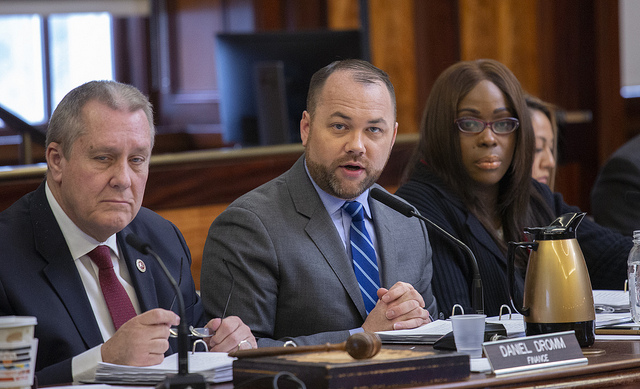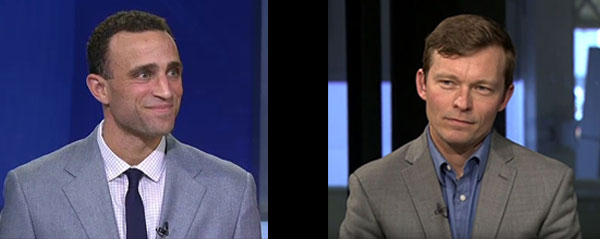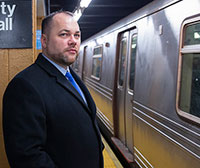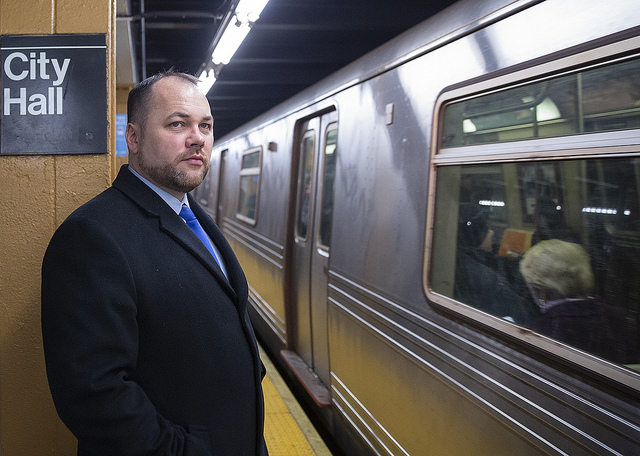City Council Pushes on De Blasio Savings Program During First Budget Hearing

(Photo: John McCarten/City Council)
City Council Speaker Corey Johnson appeared frustrated on Wednesday with the de Blasio administration budget at the Council’s first hearing to examine the mayor’s $92.2 billion preliminary budget proposal for the 2020 fiscal year, which begins July 1 of this year.
Mayor Bill de Blasio released his preliminary budget proposal last month warning of the “tough choices” the city faces as it heads towards an economic slowdown, with revenues already coming in lower than last year. For the first time since he took office, the mayor instituted a Program to Eliminate the Gap (PEG), which is meant to find the majority of $750 million in additional savings the mayor promised by the time the executive budget is released in April.
Nonetheless, the mayor’s budget increases spending by $3 billion owing largely to costs from new contracts with labor unions, education spending, debt service costs, and fringe benefits. There are few new initiatives that add costs, while the threat of state budget cuts and cost shifts continue to loom -- the state is in a tougher fiscal situation than the city. The de Blasio administration also did not include any additional allocations to the city’s reserves, which remain strong but not as robust as some watchdogs believe they must be in order to withstand a recession.
“The Council agrees that we need to be cautious but that caution needs to be exercised with precision,” Johnson said in his opening remarks at Wednesday’s hearing, worried about the possibility that the mayor’s PEG program could lead to cuts in social services. He criticized Melanie Hartzog, director of the Office of Management and Budget, for her lack of specific answers about the PEG, and expressed frustration that the mayor seemed intent on finding millions of dollars in such savings after years of having ignored similar calls from the City Council.
Johnson also noted that the mayor’s signature initiatives, such as universal pre-kindergarten, 3-K, and the ThriveNYC mental health plan spearheaded by First Lady Chirlane McCray “are flush with funding” and safe from the PEG, compared with the rest of the budget. “Just because a program or initiative is new, transformative, or a mayoral priority, should not shield it from oversight,” he said. “The Council is not a rubber stamp. Everyone else is being asked to tighten their belts, while a few key initiatives seem exempt.”
“Everything must go under a microscope,” he said of the PEG program, but insisting that the city should not take away funding from agencies “where funding is already spread thin and agencies are already struggling to meet their core missions.” He noted that, as a result of the city’s focus on particular priorities, other larger issues are ignored. For instance, the de Blasio administration has focused on affordable housing through the Housing New York plan but NYCHA residents continue to live in deplorable conditions, he said. “Inattention to issues considered secondary and to longstanding problems can lead to a remarkable phenomenon of governing by monitor,” he said. “There are now federal monitors for NYCHA, the FDNY hiring process, the city’s jails, and police reform, to name a few.”
Hartzog, the administration’s top budget official, acknowledged early on in response to Johnson’s questioning that the city may have to find additional savings once the state budget is finalized (it is due by April 1) and personal income tax revenues become clearer.
Of the $750 million savings target, she said $544 million constituted the PEG and was to come from agencies finding efficiencies and cuts (the rest will be achieved through continuing a partial hiring freeze the mayor put in place last year and through debt service payments). Those target amounts for individual agencies were released on Tuesday. They include, for instance, $123 million from uniformed forces including the NYPD, FNDY and others; Health and welfare agencies, including the Administration for Children's Services and Health + Hospitals, will have to find nearly $147 million in savings; The DOE and CUNY will have to identify $110 million; Agencies in charge of housing and economic development will have to find $52 million in savings; Another $40 million will have to come from infrastructure, libraries and cultural institutions; and several other agencies will together have to find about $70 million. Even the mayor's office will reduce spending, by about $1.6 million.
But Hartzog could not specifically say where each agency would have to look, which frustrated Johnson. “If we’re gonna have a real hearing on these cuts and do our job of oversight on the city’s budget, we can’t have a conversation with you today about whether those cuts make sense or are valuable when you’re not giving us specific programs,” he said. “This is strange to me.”
Hartzog, though, emphasized that OMB was working with agencies on the PEG and would have all the information by the executive budget. “This is not anything new that we have done,” she said.
Tensions seemed to rise between Johnson and Hartzog at times, including when he suggested that top OMB officials don’t treat Council finance staff with respect and have long ignored the Council’s recommendations on finding new revenues and agency efficiencies. When Hartzog refused to state her opinion on the city’s dearth of funding for outreach efforts for the 2020 Census, Johnson asked rhetorically, “Why are we having this hearing?”
Johnson and his colleagues, Council Member Daniel Dromm, who chairs the finance committee, and Council Member Vanessa Gibson, who chairs the capital budget subcommittee, also raised concerns about the city’s ten-year capital strategy and the lack of planned investments in the latter half of the plan.
Dromm pointed to several expenses that were missing from the budget including discretionary Council funding, which was $391.3 million last year; additional costs for school bus services as the Department of Education is in the process of securing new contracts; several one-time education programs funded up to $122.6 million last year; and an overtime budget worth $1.3 billion, $400 million lower than the average overtime spending from the last five years.
“More than ever we need to keep growing our reserves to protect against shortfalls and painful mid-year cuts to vital services,” he said. “Indeed, we can’t afford not to.”
Gibson, whose subcommittee was created last year to specifically examine the problem-ridden capital process, said the administration “continues to fail to comply with the letter and the spirit of our charter” in providing the necessary documents about the capital budget. The $104.1 billion preliminary ten-year capital strategy is $14.5 billion more than the last ten-year strategy that was approved by the Council.
Hartzog did have one piece of good news about the city’s capital budget. She noted that Moody’s Investors Service upgraded the city’s general obligation bond rating, which would lower the city’s borrowing costs. Dromm later said the Council projected about $343 million in savings from that rating upgrade though OMB did not have its own projection.
But the strategy, Gibson said, includes several instances of “unrealistic planning,” noting that $75.5 billion or 72.6 percent of the ten-year capital strategy is outlined for just the first five years. For instance, it includes $853 million for NYPD facilities in the first three years and only $160 million for the same need in the next seven years. The capital budget also includes “significant excess appropriations” and does not track capital project spending or completion, Gibson noted.
“This issue is not new to this administration,” she said, though she did praise officials for reducing excess appropriations last year by $5.9 billion and adding new budget lines to give more clarity to the process.
Hartzog conceded that capital planning has been a challenge for the city but that the administration has been working to distribute capital expenditures across the ten-year plan. “We’re gonna continue to work on that so that you will see over time that the...out-years of the ten-year plan smooth out and it wouldn’t be as high in the first five years,” she said.
Comptroller Scott Stringer and officials from the Independent Budget Office (which released a report on the budget on Wednesday) also testified before the Council on Wednesday. Stringer, who released his own analysis of the mayor’s preliminary budget last week, continued to emphasize the need for a greater budget cushion by putting away more funding in reserves. “Given the uncertainty on the horizon, I am increasingly concerned that we simply have not done enough to hedge against the risks,” he said in his testimony.
The Council will continue to evaluate the preliminary budget over the next several weeks, with specific agency heads being called to testify, before the Council issues its response. The mayor’s updated executive budget in April will then go through another round of Council hearings before the final spending plan for the next year is adopted.
***
by Samar Khurshid, senior reporter, Gotham Gazette
@samarkhurshid @GothamGazette
Note - this article has been updated with PEG targets released by the mayor's office and to clarify that the PEG is meant to find $544 million in savings, not the total $750 million.
Max & Murphy Podcast: Should the City Run the Subways?

Ben Max, left, of Gotham Gazette, and Jarrett Murphy, right, of City Limits
March 6, 2019 - Max & Murphy Podcast: Should the City Run the Subways?
 New York City Council Speaker Corey Johnson has proposed a city takeover of the subways, part of a lengthy and ambitious new transit plan he announced at this first State of the City speech. The hosts discuss Johnson's proposals and some other recent New York political news, and get a surprise call-in from the Speaker himself.
New York City Council Speaker Corey Johnson has proposed a city takeover of the subways, part of a lengthy and ambitious new transit plan he announced at this first State of the City speech. The hosts discuss Johnson's proposals and some other recent New York political news, and get a surprise call-in from the Speaker himself.
Listen to the conversation and let us know what you think -- we're on Twitter @TweetBenMax and @JarrettMurphy. You can listen to the show through the embedded audio below or download the episode wherever you get your podcasts, under "Max & Murphy," and listen to Max & Murphy live on Wednesdays at 5 p.m. on WBAI radio, 99.5FM or wbai.org
***
by Ben Max, Gotham Gazette
@tweetBenMax @GothamGazette
Johnson Calls for Municipal Control of Subways and Buses, Pledges Congestion Pricing and 'Master Plan for City Streets'

Speaker Johnson (photo: William Alatriste/City Council)
New York City Council Speaker Corey Johnson unveiled an ambitious proposal for municipal control of the city’s mass transit system on Tuesday at his first State of the City speech at LaGuardia Community College in Queens.
“I am not here to be typical,” Johnson, who is considering a run for mayor in 2021, promised early on as he delivered a speech focused on nothing but transit, including a forceful push for replacing the Metropolitan Transportation Authority, the state entity that controls the city’s subways and buses, with a new entity called Big Apple Transit (BAT), under the control of the mayor. While the complex proposal would need approval from state lawmakers and likely faces a challenging path to passage, something Johnson acknowledged, he also outlined various plans and ideas for city transit and use of public space that are under the control of the city.
The speaker, who just began his second year leading the 51-member Council, also revealed that he intends to introduce legislation to require the city produce a “master plan for city streets” in order to improve surface transportation and street safety infrastructure, make the city more hospitable to bikers and pedestrians, and reduce the number of cars on city streets. He also made a number of suggestions to speed buses up that the city can execute, and Johnson also proposed a new deputy mayor position to oversee transportation policy and programs.
Johnson’s speech was accompanied by the release of a 101-page report titled “Let’s Go” that dives deep into the issues plaguing the city’s mass transit system, the history of the current bureaucratic system that control it, and a soup-to-nuts vision for transforming it over the next few decades.
“This is a ticking time bomb,” Johnson said, bemoaning the decline in subway and bus ridership in the last few years. “If we can’t move people around, New York City can’t function.” In many ways, the city’s mass transit system is the engine of its economy. In October 2017, City Comptroller Scott Stringer found that subway delays cost the city about $389 million every year in lost productivity and wages. Johnson emphasized that point on Tuesday as he criticized recent efforts to improve the MTA as “Band-Aid solutions to mortal wounds.”
Johnson pitched his own bold vision in direct contrast to what he said was insufficient new plans from Governor Andrew Cuomo and Mayor Bill de Blasio, though he did not name them. The two recently released a ten-point plan to “transform and fund the MTA” that includes implementation of a congestion pricing scheme. Johnson said he was presenting his plan because no one was doing “anything real” to save the city’s lifeblood transit network.
Johnson said his proposed new transit agency would be funded through several dedicated streams including local congestion tolls if the state Legislature and governor fail to pass a comprehensive congestion pricing program this year. He indicated he had the votes in the City Council to make it happen. He also called on the state to give the city the authority to raise taxes on corporations that are fully deductible at the federal level.
The BAT would also not suffer from the issues that currently plague the bloated bureaucracy of the MTA, he said. “Right now, it’s a Frankenstein’s monster of transit subsidiaries with a 3,000 person headquarters layered on top,” he said of the state authority, run by a board with representatives of several officials, where the governor has a plurality of appointees and names the chair. The BAT, on the other hand, would be leaner, more efficient, and with clear lines of accountability with the mayor on top. “Under municipal control, we will do a full audit of every part of the MTA we take over,” he said.
Municipal control would also allow the city to better control the costs of subway construction, which are exponentially higher than other developed nations with similar transit needs, Johnson said. “Adding a single mile of subway track in New York City costs the same as sending a rover to Mars,” he quipped.
Though the city does not control the subways and buses, Johnson does plan to flex the Council’s authority to mandate improvements to streets and sidewalks through the proposed “master plan,” to be required every five years. Among its top-line mandates would be the creation of 50 miles of protected bike lanes every year with a "fully connected bike network covering the city by 2030"; installing transit signal priority at all of the city’s 325 bus routes by 2030, up from the 12 where it is currently in place; making all intersections with pedestrian signals accessible by 2030; and expanding accessibility for disabled New Yorkers to all 472 subway stations, of which only 118 are currently accessible.
He said the Council will develop a zoning proposal to facilitate those subway accessibility improvements at 300 stations located adjacent to underdeveloped land and offer a “density bonus” to developers for other station improvements.
“Let’s break the car culture. We have been living in Robert Moses’ New York for almost a century, and it is time to move on,” Johnson declared, taking aim at the infamous public official who was responsible for building a transit infrastructure network that favored wealthier car-owning residents and sidelined lower-income New Yorkers who relied on mass transit. Johnson also suggested that the city’s plan to rebuild a mile-and-a-half section of the Brooklyn-Queens Expressway (BQE), a Moses legacy item, at a cost of $4 billion was misguided. “That’s almost two Mars rovers,” he joked, going on to say that there has to be a better way that isn’t so car-focused.
Johnson’s speech repeatedly appeared as a rebuke to Cuomo and de Blasio, who have feuded over subway funding for years but recently came together to support a congestion pricing program with few details. Cuomo has repeatedly tried to distance himself from the subway crisis, claiming that he does not control the MTA even though he appoints a plurality of its board members and its senior leadership and the board has never gone against Cuomo’s wishes. Cuomo is also fond of invoking Robert Moses when talking of his own infrastructure record. The mayor, in turn, has tried to wash his hands of the MTA’s troubles by blaming the governor, though de Blasio appoints four MTA board members and the city has more control over the buses than the subways, by virtue of its powers over the streets. De Blasio has taken little interest in reducing congestion and speeding buses, though he announced during his own recent State of the City speech several plans to address the bus crisis facing the city. Johnson’s go further.
And though de Blasio’s Vision Zero plan to eliminate traffic fatalities through street redesigns and other projects has been successful, the mayor continues to face criticism for not going far enough and for being an avid proponent of car culture. Case in point, he rarely rides the subways unless it is to promote a transit-related announcement and he drives 12 miles to the gym.
Both de Blasio and Cuomo's offices were quick to throw cold water on Johnson's announcement. "A City takeover of the subways is a worthy discussion that in a best-case scenario would take years to achieve," de Blasio spokesperson Eric Phillips said in a statement. "While he appreciates the Speaker’s transit vision and contribution, the Mayor is focused on immediate actions to fix the broken subway system. Our subways are in the middle of a crisis that needs an immediate solution. The Mayor stands with millions of riders depending on action right now. We have four weeks to deliver sustainable revenue sources capable of turning this crisis around."
Dani Lever, a spokesperson for the governor, tweeted, "A few facts -- NYC owns the NYC transit system and can cancel the MTA lease with one year's notice; the City's civil service staffs the system; and the Mayor has total veto over the State and City funded NYCT capital plan."
Johnson made clear in his speech on Tuesday that his focus on mass transit was more than just about reducing train delays or traffic deaths. “This is a progressive issue. It always has been,” he said, as he spoke of the low-income New Yorkers who are most affected by failing transit and the heavy cost on the environment of the city’s car culture. “We need to change the way we think about big problems,” he said.
***
by Samar Khurshid, senior reporter, Gotham Gazette
@samarkhurshid @GothamGazette
Note - This article has been updated with statements from spokespeople for Mayor de Blasio and Governor Cuomo.




